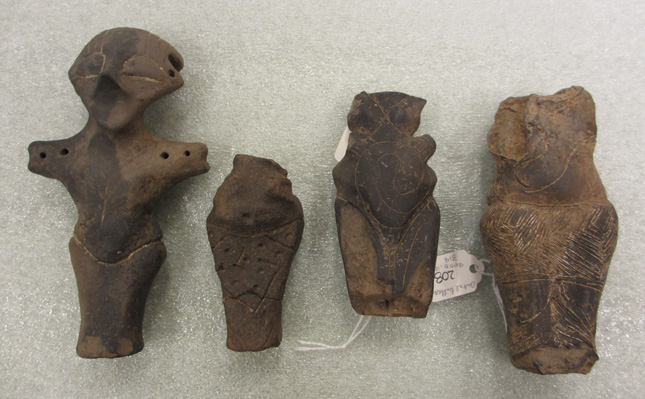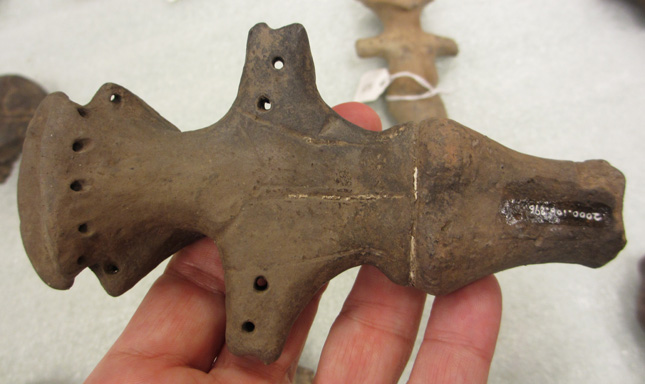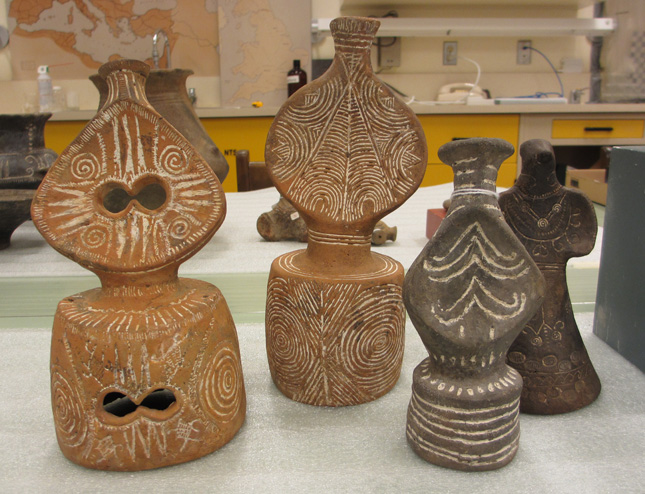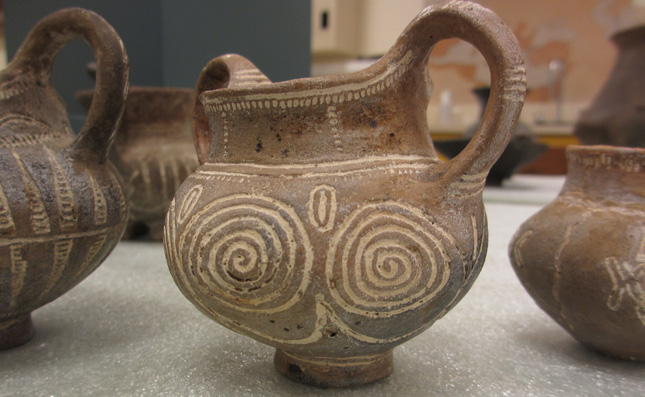ROM Goddesses on display for Archaeology Weekend
As part of Archaeology Weekend on April 14 and 15 we will be putting on a small display of objects from out of the ROM’s vaults. We are calling it Treasures of the Danube: Enigmatic Objects from Balkan Prehistory.
One case will be of figurines from the Vinča culture (circa 5,500 and 4,500 BC), which can be found in the region of Serbia. Farming had been introduced in about 6,400 BC to the region, but the Vinča is a unique development of the region. They had unusually large settlements, and started the first metal-working in Europe.
One of the features of the Vinča is the making of cult figures like those in this case. As seems quite common in many cultures, it is the female deity that is created in these small objects of veneration within the home, as only one of these is clearly a male. The females are depicted with open welcoming arms, or with their arms bent down, possibly to show an embrace. They wear long narrow dresses, with bold designs on them, and have holes where jewelry was probably attached, and other holes at the back of the head for hair. There seems to be an under-dress, which would perhaps been of linen, a patterned over-dress, perhaps of wool, and often an apron – quite like the traditional dress of the region. These goddesses are not skinny girls, they actually have perceptively-depicted love-handles! The first photo shows a recreation of a lady, and one of the figures it is based on. The second photo is of another goddess that is the motif for the weekend – our poster goddess you might say!

Four goddesses of the Vinca culture - the Spice Girls of the 5th millennium BC? The one on the left is the main poster-goddess of Archaeology Weekend. Note the boldly decorated clothing (although one is topless).
 The back of our poster goddess shows clearly the holes for jewelry and hair attachment.
The back of our poster goddess shows clearly the holes for jewelry and hair attachment.
The second case includes objects of the Bronze Age cultures of the Danube, including the Vučedol culture (3,000 to 2,200 BC). One aspect of continuity was the way of making pottery with incised decoration that is then filled with white lime. The symbols found on this pottery mark it as very significant. The preceding Vinča culture had so many symbols, probably an entire vocabulary of meaning, that some people have suggested that they form a written language. Many of the same symbols may be seen on this pottery. The figures of goddesses, made for worship in the household, are radically stylised versions of the Vinča goddesses. What were enveloping arms have become a disc, and their long dresses have become cylinders – without the preceding more naturalistic figures we might not work out what they are at all!
But like all cultures that existed before history, the meanings of these objects and the symbols on them are truly a mystery! What is also a mystery is when these enigmatic objects will be on display again! Come to the ROM between April 11th and April 19th to view them!
 Four Bronze Age goddesses - the Spice Girls of the 2nd millennium BC? These are much more stylised, but still you can see the long dress, the narrow waist, embracing arms, and crowned head.
Four Bronze Age goddesses - the Spice Girls of the 2nd millennium BC? These are much more stylised, but still you can see the long dress, the narrow waist, embracing arms, and crowned head.
 Symbolic ceramics - the many symbols on these objects would have had significant meaning to the maker and t he owner. It is only in the modern age, an age increasingly devoid of meaning, that we have design for design's sake. In societies still linked to their traditions, symbols like this will have deep meaning to the societies, and to the individuals themselves, and this is certainly what we see here, although the true meaning is lost in the mists of prehistory.
Symbolic ceramics - the many symbols on these objects would have had significant meaning to the maker and t he owner. It is only in the modern age, an age increasingly devoid of meaning, that we have design for design's sake. In societies still linked to their traditions, symbols like this will have deep meaning to the societies, and to the individuals themselves, and this is certainly what we see here, although the true meaning is lost in the mists of prehistory.
